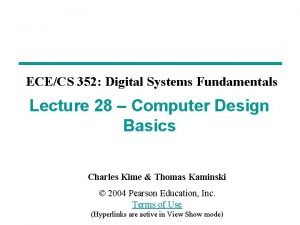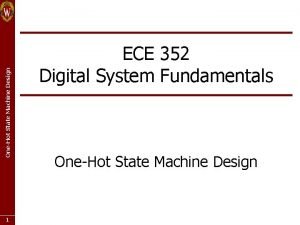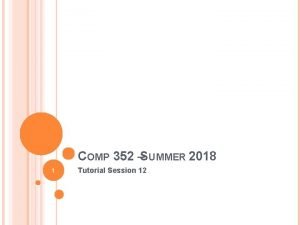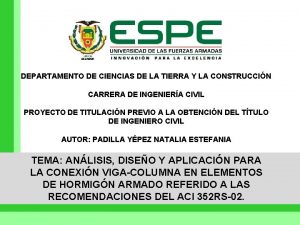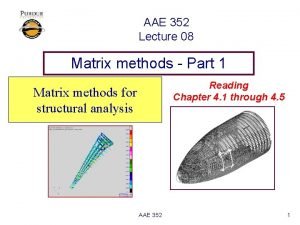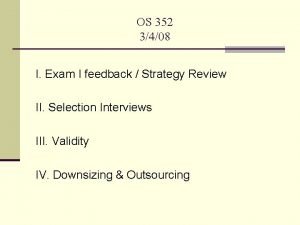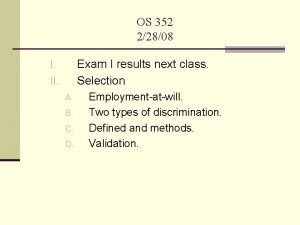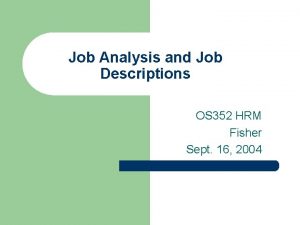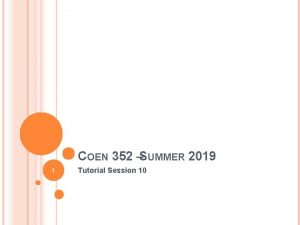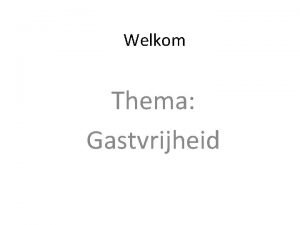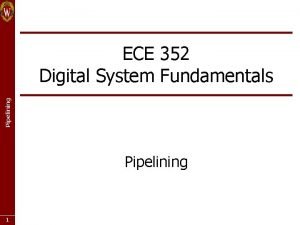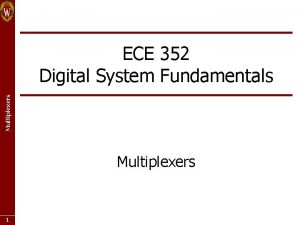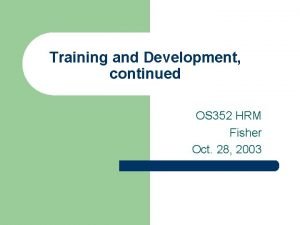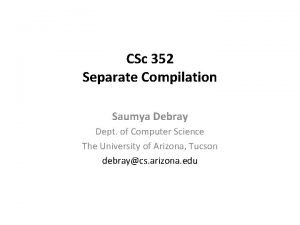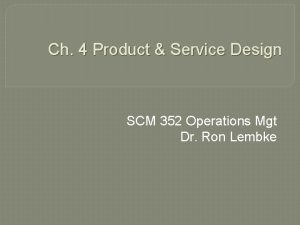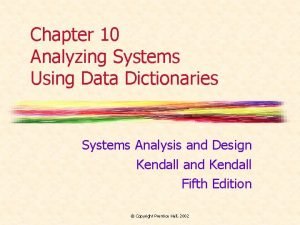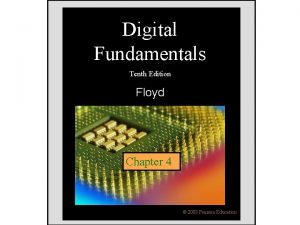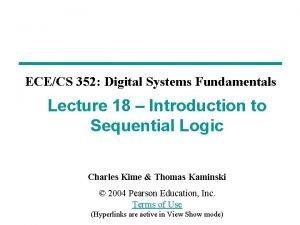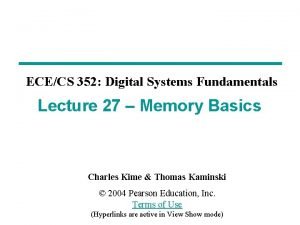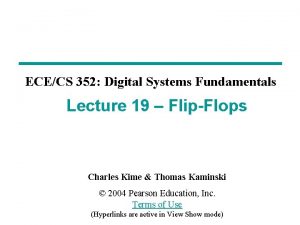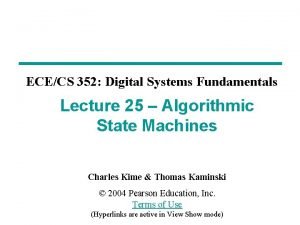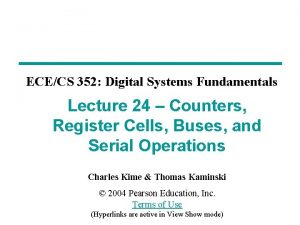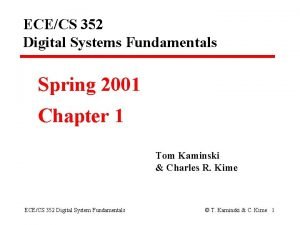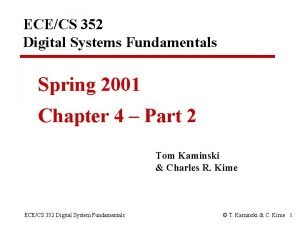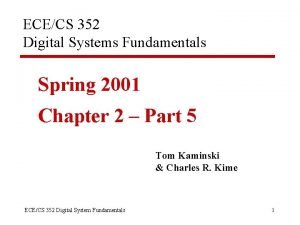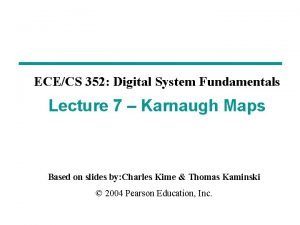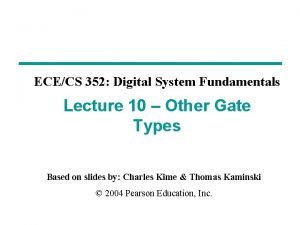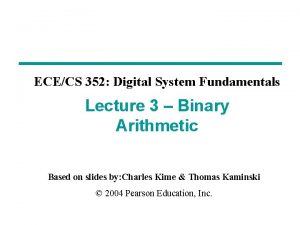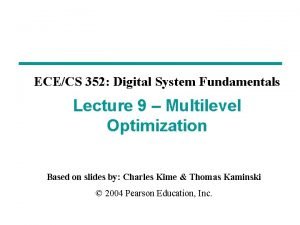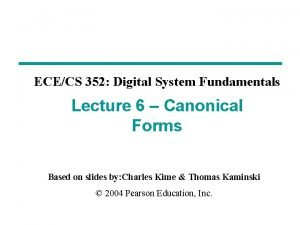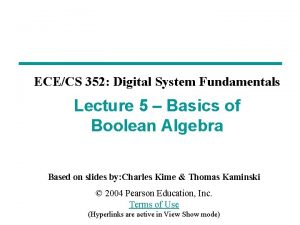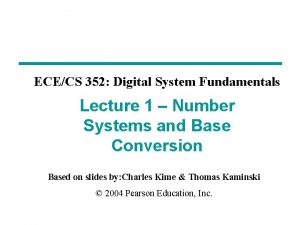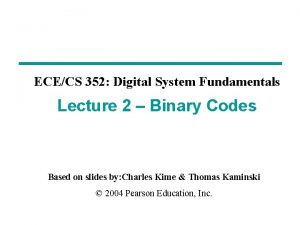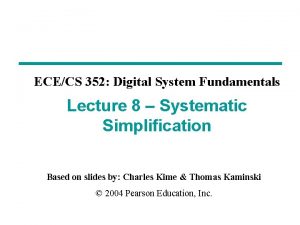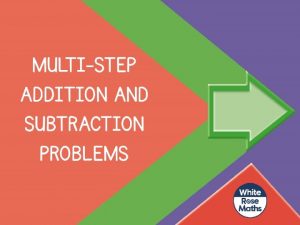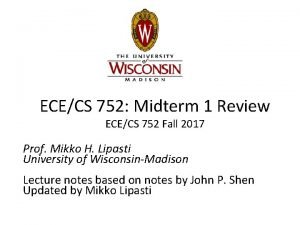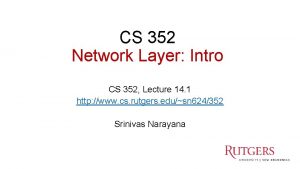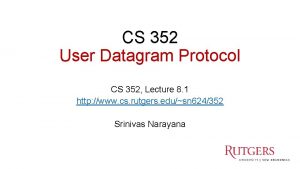ECECS 352 Digital Systems Fundamentals Lecture 20 Analyzing























- Slides: 23

ECE/CS 352: Digital Systems Fundamentals Lecture 20 – Analyzing Sequential Logic Charles Kime & Thomas Kaminski © 2004 Pearson Education, Inc. Terms of Use (Hyperlinks are active in View Show mode)

Overview § Finite State Machine Model § State Tables § State Diagrams § Moore and Mealy Models § Circuit and System Level Timing 2

Finite State Machine Model § General Model Inputs Outputs • Current State Combinaat time (t) is tional Storage Logic stored in an Elements array of Next flip-flops. State • Next State at time (t+1) CLK is a Boolean function of State and Inputs. • Outputs at time (t) are a Boolean function of State (t) and (sometimes) Inputs (t). 3

Example 1 (from Fig. 6 -17) § § Input: x(t) x Output: y(t) State: (A(t), B(t)) What is the Output Function? D § What is the Next State Function? Q A C Q A Q B D CP C Q y 4

Example 1 (continued) § Where in time are inputs, outputs and states defined? 1 0 0 0 1 0 5

Example 1: State Table § The state table can be filled in using the next state and output equations: Present State Input A(t) B(t) 0 0 0 1 0 1 1 1 1 x(t) 0 1 0 1 Next State Output A(t+1) B(t+1) 0 0 0 1 0 0 1 0 y(t) 0 0 1 0 1 0 6

Example 1: Alternate State Table § 2 -dimensional table that matches well to a K-map. Present state rows and input columns in Gray code order. • A(t+1) = A(t)x(t) + B(t)x(t) • B(t+1) = A (t)x(t) • y(t) = x (t)(B(t) + A(t)) Present Next State Output State x(t)=0 x(t)=1 x(t)=0 x(t)=1 A(t) B(t) A(t+1)B(t+1) y(t) 0 0 0 1 0 0 0 1 0 0 1 1 1 0 1 1 0 0 1 0 1 0 0 0 1 0 1 0 7

State Diagrams x=0/y=0 § Graphical specification § Nodes states x=1/y=0 § Edges transitions x=0/y=1 AB 00 • Based on state and input x=0/y=1 1 0 x=1/y=0 x=0/y=1 • Depend on inputs § Outputs x=1/y=0 01 11 x=1/y=0 8

Moore and Mealy Models § Finite State Machines (FSMs) have two formal models: § Moore Model • Named after E. F. Moore. • Outputs are a function ONLY of states • Usually specified on the states. § Mealy Model • Named after G. Mealy • Outputs are a function of inputs AND states • Usually specified on the state transition arcs. § In contemporary design, models are sometimes mixed Moore and Mealy 9

Moore and Mealy Example Diagrams § Mealy Model State Diagram maps inputs and state to outputs x=0/y=0 x=1/y=0 1 0 x=0/y=0 x=1/y=1 § Moore Model State Diagram x=0 maps states to outputs 0/0 x=1 x=0 1/0 2/1 x=1 10

Moore and Mealy Example Tables § Mealy Model state table maps inputs and state to outputs Present Next State Output State x=0 x=1 0 0 1 0 1 § Moore Model state table maps state to Present Next State Output outputs State 0 1 2 x=0 x=1 0 2 0 2 0 0 1 11

Sequential Circuit Analysis Example § Logic Diagram: D Q A C RQ D Q B C RQ D Clock Reset Q CR Q 12 C Z

Example 2: Flip-Flop Input Equations § Variables • Inputs: None • Outputs: Z • State Variables: A, B, C § Initialization: Reset to (0, 0, 0) § Equations: 13

Example 2: State Table X’ = X(t+1) A B C A’B’C’ Z 0 0 0 1 0 0 1 1 1 0 0 1 0 1 1 1 0 1 1 1 0 0 1 0 0 1 1 1 0 0 0 1 0 0 1 1 14

Example 2: State Diagram Reset 111 ABC 000 100 001 010 § Which states are used? § What is the function of the circuit? 101 110 15

Circuit and System Level Timing § Consider a system comprised of ranks of flip-flops connected by logic: § If the clock period is too short, some data changes will not propagate through the circuit to flip-flop inputs before the setup time interval begins D Q D Q C Q' C Q' D Q C Q' CLOCK 16

Circuit and System Level Timing (continued) § Timing components along a path from flip-flop to flip-flop tp C tpd, FF tpd, COMB ts tslack (a) Edge-triggered (positive edge) tp C tpd, FF tpd, COMB tslack ts (b) Pulse-triggered (negative pulse) 17

Circuit and System Level Timing (continued) § New Timing Components • tp - clock period - The interval between occurrences of a specific clock edge in a periodic clock • tpd, COMB - total delay of combinational logic along the path from flip-flop output to flip-flop input • tslack - extra time in the clock period in addition to the sum of the delays and setup time on a path § Can be either positive or negative § Must be greater than or equal to zero on all paths for correct operation 18

Circuit and System Level Timing (continued) § Timing Equations tp = tslack + (tpd, FF + tpd, COMB + ts) • For tslack greater than or equal to zero, tp ≥ max (tpd, FF + tpd, COMB + ts) for all paths from flip-flop output to flip-flop input § Can be calculated more precisely by using t. PHL and t. PLH values instead of tpd values, but requires consideration of inversions on paths 19

Calculation of Allowable tpd, COMB § Compare the allowable combinational delay for a specific circuit: a) Using edge-triggered flip-flops b) Using master-slave flip-flops § Parameters • • tpd, FF(max) = 1. 0 ns ts(max) = 0. 3 ns for edge-triggered flip-flops ts = tw. H = 1. 0 ns for master-slave flip-flops Clock frequency = 250 MHz 20

Calculation of Allowable tpd, COMB (continued) § Calculations: tp = 1/clock frequency = 4. 0 ns • Edge-triggered: 4. 0 ≥ 1. 0 + tpd, COMB + 0. 3 → tpd, COMB ≤ 2. 7 ns • Master-slave: 4. 0 ≥ 1. 0 + tpd, COMB + 1. 0 → tpd, COMB ≤ 2. 0 ns § Comparison: Assume average gate tpd = 0. 3 ns • Edge-triggered: Approximately 9 gates allowed on a path • Master-slave: Approximately 6 to 7 gates allowed on a path 21

Summary § Finite State Machine Model § State Tables § State Diagrams § Moore and Mealy Models § Circuit and System Level Timing 22

Terms of Use § © 2004 by Pearson Education, Inc. All rights reserved. § The following terms of use apply in addition to the standard Pearson Education Legal Notice. § Permission is given to incorporate these materials into classroom presentations and handouts only to instructors adopting Logic and Computer Design Fundamentals as the course text. § Permission is granted to the instructors adopting the book to post these materials on a protected website or protected ftp site in original or modified form. All other website or ftp postings, including those offering the materials for a fee, are prohibited. § You may not remove or in any way alter this Terms of Use notice or any trademark, copyright, or other proprietary notice, including the copyright watermark on each slide. § Return to Title Page 23
 Ececs
Ececs Financial investment analysis
Financial investment analysis 01:640:244 lecture notes - lecture 15: plat, idah, farad
01:640:244 lecture notes - lecture 15: plat, idah, farad Ece 352
Ece 352 It 352
It 352 352 formação
352 formação Comp352
Comp352 Union viga columna hormigon armado
Union viga columna hormigon armado Troop 352
Troop 352 Aae 352
Aae 352 Exam feedback examples
Exam feedback examples Os 352
Os 352 Os 352
Os 352 Coen 352
Coen 352 Opwekking 464
Opwekking 464 Ece 352
Ece 352 Tmk 352
Tmk 352 Ece 651
Ece 651 Os 352
Os 352 Saumya debray
Saumya debray Scm 352
Scm 352 Analyzing systems using data dictionaries
Analyzing systems using data dictionaries Digital fundamentals chapter 4
Digital fundamentals chapter 4 Digital fundamentals by floyd
Digital fundamentals by floyd
